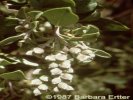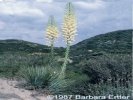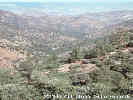 Carl Purpus, Plant
Collector in Western America
Carl Purpus, Plant
Collector in Western America 
by C. A.
Purpus
Daunt, Tulare County, August 1897
 Carl Purpus, Plant
Collector in Western America Carl Purpus, Plant
Collector in Western America | Report of My Journey in the Southern Sierra Nevada and the Argus and Madurango Ranges |
 | by C. A.
Purpus |
 




|
Original Title: Bericht uber meine Tour in die sudliche Sierra Nevada und die Argus und Madurango Ranges Von C. A. Purpus, Daunt, Tulare Co. im August 1897. Mitt. Deutsch. Dendrol. Ges. 6: 313-318.
| Other Articles: On the Trail…: 0260 Locations: Deer Creek. Porterville. Springville.
On the 8th of May [1897], a splendid but fairly hot day, I departed by wagon from Springville, on the confluence of the Middle and North Tule River, on a several month tour of the region described in the title. We first made our way west to the small town of Porterville, distinguished by it lovely orange and
citrus groves. From here we went south through an undistinctive hilly area, partly treeless, partly forested on the slopes with Quercus douglasii. The oaks of the lower regions were Quercus douglasii and Q. lobata, the former growing on the hills, the latter in the valleys and plains. The entire landscape had already set aside its spring finery, and the golden wheatfields awaiting harvest stretched for miles. The occasional watercourses meandered as green ribbons, bordered by willows and poplars (Populus fremontii).
|
| Other Articles: Collecting in the Sierra Nevada: 0140 On the Trail…: 0270 Locations: Blue Mountains. White River.
By evening we arrived and camped at Deer Creek, a broad, sandy, half-dried stream. The next morning we departed toward White River, a small mining town at the base of the Blue Mountains. Gold mining had once been attempted here, but the venture was not very productive.
|
| Locations: Blue Mountains. Greenhorn Range. Linns Valley. From here we went steeply uphill
eastward along a small, half-dried stream, along which I noticed more willows and Populus fremontii as well as Platanus racemosa. These trees are found along the mountain rivers and streams throughout the middle elevations, often ascending to nearly 4000 feet. We came to Linns Valley, a hilly valley thinly wooded with Quercus douglasii that lies at an elevation of 3-4000 feet between the Blue Mountains and the Greenhorn Range. Here we found spring, and hill and dale were clothed in a glad green. We made camp under a grove of Quercus douglasii on a green flat.
|
|  Garrya pallida var. flavescens.
Garrya pallida var. flavescens.
Locations: Greenhorn Pass. Kern River Valley. On another morning we continued our
journey toward Greenhorn Pass, gateway to the Kern River valley. On the mountain slopes grew the typical chaparral shrubs, including the splendid Fremontia californica. Above the shrubs rose Pinus sabineana with its massive hanging cones. The tree does not occur in the the Tule River area but is the dominant tree in the Coast Ranges of middle California. An excellent, well-shaded trail led us rather steeply uphill toward Greenhorn Pass. In the Quercus breweri zone at about 4-5000 feet, I noticed an interesting Garrya, probably G. flavescens or G. veatchii Kell., laden with fruit. This interesting shrub is called "quinine tree" because all of its parts contain a terribly bitter substance. Quercus breweri, which first appeared above 4000 feet, forms dense thickets here that are difficult to penetrate. On the lower boundary I found it intermixed with Fremontia californica, Ceanothus, and the Garrya.
|
| Locations: Cedar Creek. We camped in the
vicinity of Cedar Creek, a small, crystal-clear mountain stream some 1000 feet below the pass. The next morning we continued our journey. Before noon, we reached the summit of the pass at 6-7000 feet. We found ourselves at the limit of Quercus kelloggii at 6000 feet and entered the zone of Abies concolor, Libocedrus decurrens, Pinus lambertiana, and P. jeffreyi. This last species took the place of Pinus jeffreyi, which is found at these elevations
farther north. Sequoia[dendron] gigantea does not occur here.
|
|  Yucca whipplei.
Yucca whipplei. Other Articles: Collecting in the Sierra Nevada: 0150 Locations: Kern River. On the eastern side
of the pass the trail led steeply downhill. The forest became more and more open, and the chaparral also thinned out. Masses of Yucca whipplei, sending up its huge inflorescences, grew on the slopes. From the heights, I was treated to a beautiful view of the green valley where the North and South Forks of the Kern River meet, bounded by steep, rather bare, rocky
mountains. At lower elevations, between 3000 and 4000 feet, I found a splendid Compositae, a low shrub covered with large yellow flowers, growing with Tetradymia canescens DC., a shrubby Eriogonum, and Opuntia basilaris Engelm. The trees included Quercus douglasii, Pinus sabineana, and Juniperus californica, which resembled J. occidentalis but had a different habit and larger fruit. Salix spp. and Populus fremontii lined the river.
|
|  Lookout Point (Old Piute Vista), Piute Mountains, California.
Lookout Point (Old Piute Vista), Piute Mountains, California.
Locations: Erskine Creek. Hot Spring Valley. Lookout Point.
We crossed Kern River and travelled southward through Hot Spring Valley, an arid, totally treeless valley bordered by steep slopes. We were heading for Erskin[e] Creek, from whence a trail led to Piute ["Pinte"] Peak, where I had thought to spend a few weeks botanizing. We travelled across a gently sloping plain covered partly with Yucca whipplei, partly with scattered trees and shrubs, including Tetradymia canescens and other Compositae. I found the interesting Salvia carnosa [=S. dorrii] in some spots.
|
|  Erskine Creek drainage, Piute Mountains, California.
Erskine Creek drainage, Piute Mountains, California.
Other Articles: On the Trail…: 0280 Locations: Erskine Creek. Letters: 5/23/1897
It was evening by the time we reached Erskine Creek, so we decided to spend the night here. More willows, Populus fremontii, and Platanus racemosa grew along the stream. We followed the crystal clear creek upstream the following afternoon, to where it flowed out of a narrow glen. Pinus monophylla and Juniperus californica grew on the steep cliffs, later joined by P. sabineana.
|
| The glen eventually
widened and the slopes were not as steep. Both of the
aforementioned conifers were joined by Quercus douglasii and a shrubby species
resembling Q. dumosa. In the valley proper grew Quercus wislizeni and Q.
chrysolepis. The willows were joined by Populus fremontii and Alnus rhombifolia.
On the slopes were Ceanothus vestitus, Fremontia californica, Artemisia
tridentata, and assorted shrubby Compositae and Eriogonum. I also found here,
but only sporadically, the interesting Prunus fasciculata with its almondlike
fruits.
|
| The chaparral was
only on the north slopes of the mountains, and dense only in certain zones over 4-6000'. The south slopes were primarily characterized by a sparse shrubbery between which grew large quantities of Yucca whipplei, a lovely sight to see with it large inflorescence of large bell-like flowers rising above its leaves. The already mentioned Pinus monophylla and Juniperus
californica were also there, as was Quercus douglasii at lower elevations. Juniperus californica and Pinus sabineana ascended to nearly 6000 feet, while Pinus monophylla went somewhat higher.
|
|  Erskine Creek drainage, Piute Mountains, California.
Erskine Creek drainage, Piute Mountains, California.
Locations: Piute Peak. Letters: 5/23/1897
Around 4 PM we came to the foot of Piute Peak, which rose nearly 4000 feet above the enchanting narrow valley of Erskine Creek. Its highest summit, which was not visible from the valley, reaches a height of over 8000 feet. Our tent was erected on an attractive site on Erskine Creek, shaded by large Pinus sabineana. I decided to remain here for several weeks.
|
| I climbed the
mountain the following morning. A good trail led to the mines, and from there up a stony slope all the way to the summit. From here one could look out over the mountains of southeastern California, a large part of the Mojave Desert, and, over to the southwest, the 11,000 foot high San Bernardino Mountains. At the foot of the mountain grew the aforementioned shrubs together with Arteminsia tridentata, followed by the scrub-oak Quercus breweri, which forms nearly impenetrable thickets. The higher I went, the less dense were the shrubs. Yucca whipplei became dominant, between Ceanothus and Garrya. From 4500 to 5000 feet, Pinus sabineana and P. monophylla reappeared. Pinus jeffreyi and P. lambertiana appeared at 7000 feet, followed by Abies concolor. Other conifers did not occur, except for a Cupressus* that I did not recognize on sight, but which I later saw covering a rocky slope at 5-6000 feet altitude. Opuntia basilaris and O. treleasii, distinctive in the marvelous coloration of its abundant showy flowers, were frequently encountered on sunny slopes.
| |
[Next Page] | |
| [Published Biographies] [Travelogues and Articles] [Letters] [Plant Lists and Bibliography] [Site Administration] | | Date and time this article was prepared: 6/7/2002 7:32:11 PM |